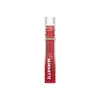What's inside
What's inside
 Key Ingredients
Key Ingredients

 Benefits
Benefits

No benefits
 Concerns
Concerns

 Ingredients Side-by-side
Ingredients Side-by-side

Dimethicone
EmollientDimethicone Crosspolymer
Emulsion StabilisingPolyglyceryl-2 Triisostearate
EmulsifyingDimethicone/Vinyl Dimethicone Crosspolymer
Skin ConditioningTribehenin
EmollientIsononyl Isononanoate
EmollientTitanium Dioxide
Cosmetic ColorantGlyceryl Caprylate
EmollientCaprylyl Glycol
EmollientSilica
AbrasiveButylene Glycol
HumectantTocopherol
AntioxidantParfum
MaskingCI 19140
Cosmetic ColorantCI 77491
Cosmetic ColorantPigment Red 57
Cosmetic ColorantCI 45410
Cosmetic ColorantCI 15985
Cosmetic ColorantDimethicone, Dimethicone Crosspolymer, Polyglyceryl-2 Triisostearate, Dimethicone/Vinyl Dimethicone Crosspolymer, Tribehenin, Isononyl Isononanoate, Titanium Dioxide, Glyceryl Caprylate, Caprylyl Glycol, Silica, Butylene Glycol, Tocopherol, Parfum, CI 19140, CI 77491, Pigment Red 57, CI 45410, CI 15985
Dimethicone
EmollientVinyl Dimethicone/Lauryl Dimethicone Crosspolymer
Diisostearyl Malate
EmollientPolyglyceryl-2 Triisostearate
EmulsifyingTribehenin
EmollientSilica
AbrasiveQuartz
AbrasiveAlumina
AbrasivePolymethylsilsesquioxane
Sorbitan Isostearate
EmulsifyingCetyl PEG/PPG-10/1 Dimethicone
EmulsifyingVp/Hexadecene Copolymer
Tocopheryl Acetate
AntioxidantPhenoxyethanol
PreservativeCI 77492
Cosmetic ColorantCI 77491
Cosmetic ColorantCI 77499
Cosmetic ColorantCI 77891
Cosmetic ColorantCI 15850
Cosmetic ColorantCI 42090
Cosmetic ColorantDimethicone, Vinyl Dimethicone/Lauryl Dimethicone Crosspolymer, Diisostearyl Malate, Polyglyceryl-2 Triisostearate, Tribehenin, Silica, Quartz, Alumina, Polymethylsilsesquioxane, Sorbitan Isostearate, Cetyl PEG/PPG-10/1 Dimethicone, Vp/Hexadecene Copolymer, Tocopheryl Acetate, Phenoxyethanol, CI 77492, CI 77491, CI 77499, CI 77891, CI 15850, CI 42090
Ingredients Explained
These ingredients are found in both products.
Ingredients higher up in an ingredient list are typically present in a larger amount.
Ci 77491 is also hydrated iron III oxide. It's sole purpose is to give a red/pink hue to products.
Iron III oxides are classified as inorganic chemicals for coloring.
Synthetically created Ci 77491 is considered safer than those naturally found. This is because the synthetically created version may contain less impurities. Iron oxides are generally non-toxic and non-allergenic.
Learn more about CI 77491Dimethicone is a type of synthetic silicone created from natural materials such as quartz.
What it does:
Dimethicone comes in different viscosities:
Depending on the viscosity, dimethicone has different properties.
Ingredients lists don't always show which type is used, so we recommend reaching out to the brand if you have questions about the viscosity.
This ingredient is unlikely to cause irritation because it does not get absorbed into skin. However, people with silicone allergies should be careful about using this ingredient.
Note: Dimethicone may contribute to pilling. This is because it is not oil or water soluble, so pilling may occur when layered with products. When mixed with heavy oils in a formula, the outcome is also quite greasy.
Learn more about DimethiconeThis ingredient is a form of glycerin with emulsifying and emollient properties.
As an emulsifier, this ingredient helps keep products together while adding a thick texture. The manufacturer states this ingredient has emollient properties. Emollients help keep the skin hydrated by trapping moisture in.
Polyglyceryl-2 Triisostearate is created by reacting diglycerin and isostearic acid. Due to the isostearic acid base, it may not be safe for Malassezia or fungal acne.
Learn more about Polyglyceryl-2 TriisostearateSilica, also known as silicon dioxide, is a naturally occurring mineral. It is used as a fine, spherical, and porous powder in cosmetics.
Though it has exfoliant properties, the function of silica varies depending on the product.
The unique structure of silica enhances the spreadability and adds smoothness, making it a great texture enhancer.
It is also used as an active carrier, emulsifier, and mattifier due to its ability to absorb excess oil.
In some products, tiny microneedles called spicules are made from silica or hydrolyzed sponge. When you rub them in, they lightly polish away dead skin layers and enhance the penetration of active ingredients.
Learn more about SilicaTribehenin comes from glycerin and behenic acid.
It is used as an emollient, or moisturizer. Emollients form a thin barrier on skin to prevent moisture from escaping.
This ingredient may not be Malassezia folliculitis, or fungal-acne safe.
Learn more about Tribehenin